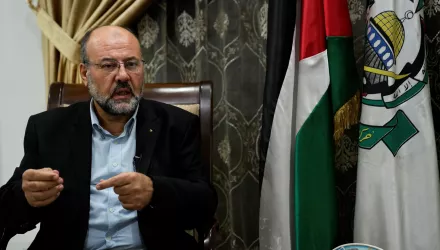Note
This policy memo is based on Thomas Hegghammer's ISP brownbag presentation, "The Origins of Global Jihad: Explaining the ArabMobilization to 1980s Afghanistan," on January 22, 2009.
Summary: The Arab involvement in Afghanistan was the result of two main factors: the entrepreneurship of the Palestinian preacher Abdallah Azzam and the rise of a "soft pan-Islamism" promoted since the mid-1970s by non-violent international Islamic organizations such as the Muslim World League.
Introduction
The Arab involvement in the 1980s Afghan jihad is widely recognized as a crucial stage in the history of militant Islamism. It generated the battle-hardened and uprooted network of Arab Afghans from which al-Qaida and other groups emerged. It also set a precedent for similar mobilizations to Bosnia, Chechnya, Iraq, and elsewhere. We know much about the consequences of the Arab involvement but much less about its causes. Why did the Arabs go to Afghanistan in the first place?
Existing explanations
The existing literature offers three main types of explanations.
- "The mobilization was state-driven." But states supported the Afghans, not the Arabs. There is almost no evidence of direct State sponsorship of Arab fighters. Moreover, the Arab volunteers were totally insignificant from a military strategic point of view — why would the states support them?
- "The mobilization was ideologically determined." But why, then, was there no such mobilization for previous conflicts in Palestine, Kashmir, Philippines, or Somalia? Moreover, there never was a spontaneous rise of the Muslim nation in 1980, Arab volunteers did not exceed 100 until 1985.
- "The mobilization reflected the rise of the Islamist movement." But the Islamists movement had both size and momentum in the 50s, 60s, and 70s, yet very few activists got involved in foreign conflicts. Moreover, guerrilla warfare abroad was not a natural extension of the domestic political project of earlier Islamists. Something new happened in the early 1980s.
Abdallah Azzam
The sufficient cause of the mobilization was the entrepreneurship of the Palestinian sheikh Abdallah Azzam. Nearly all the first volunteers had either met Azzam or red his texts. Azzam himself got involved in the Afghan jihad because he was an uprooted and stateless individual who had been evicted from his adopted homeland Jordan to Saudi Arabia in early 1981. In late 1981, he went to Pakistan following a chance meeting in Mecca with an Egyptian friend who convinced him to go. He would work relentlessly to bring Arabs to Peshawar until his assassination in 1989.
Azzam succeeded in his efforts for three principal reasons.
- He had unique resources. As an al-Azhar Ph.D. and long-standing Muslim Brother, Azzam had religious credentials, political credibility, and a vast international network of contacts. No other Arab Afghan was close to having similar qualities.
- He exercised excellent social movement entrepreneurship. Azzam lectured, wrote, lobbied, and organized, and he understood the importance of the media.
- He developed a new ideological doctrine and discourse. Azzam said all Muslims had an unconditional duty to get militarily involved in other Muslims' struggles of national liberation. He differed from most militant Islamist contemporaries who said toppling Arab rulers was more important; and from mainstream clerics, who said only the populations most concerned (in this case the Afghans) had a duty to fight occupation. But there was a deeper necessary cause for Azzam's success.
The rise of pan-Islamism
Azzam's message resonated because it coincided with a growing sense in the Muslim world that Muslims were one people challenged by external threats. This message had been promoted very actively and forcefully in the late 1970s by non-violent international Islamic organizations, above all the Muslim World League. The pan-Islamist renaissance began in mid-1970s Hijaz for three reasons. First, in this region were large institutions (MWL, OIC, University of Medina) mandated to transcend national boundaries. Second, these organizations were staffed by political activists (Muslim Brothers in exile) without a national political arena of their own. Finally, their budgets increased dramatically after 1973.
The pan-Islamism promoted by these organizations was of the soft kind; it advocated charity, not war. But the worldview that came with it was alarmist, self-victimizing, and slightly xenophobic. Azzam's jihad doctrine was a radical, but perfectly logical extension of the pan-Islamism of the Muslim World League.
Partly for this reason, the Arab fighters and the "soft pan-Islamists" were socially and organizationally intertwined. Most of the early Arab fighters in Afghanistan had links to either the Muslim Brotherhood or the Muslim World League. Azzam himself was also product of Hijazi pan-Islamism. He found refuge in Jidda after being expelled from Jordan in 1981. He found a job in Pakistan through contacts in the Hijaz. And his salary from 1981 to 1986 at the International Islamic University in Islamabad was paid by the Muslim World League.
Conclusions
- The real cradle of global jihadism is the Hijaz (not Afghanistan), the founding ideologue is Azzam (not Sayyid Qutb), and the driving ideological paradigm is pan-Islamism (not Wahhabism).
- Pan-Islamism had mobilizing power because it was a macro-nationalism centred on the Muslim nation. Arabs went to Afghanistan not because they were extremely religious but because they were extremely nationalistic on behalf of the umma.
- Structural explanations cannot explain everything. Accident, agency and leadership are more important for the evolution of small radical actors than is often acknowledged. The Arab mobilization depended on Azzam, and Azzam's involvement was the result of a random meeting in September 1981.
Hegghammer, Thomas. “The Origins of Global Jihad: Explaining the Arab Mobilization to 1980s Afghanistan.” January 22, 2009



